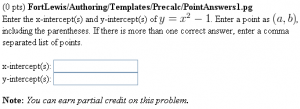Difference between revisions of "PointAnswers1"
(Removes the AnswerFormatHelp macro and some other cleanup.) |
(add historical tag and give links to newer problems.) |
||
| Line 1: | Line 1: | ||
| + | {{historical}} |
||
| + | |||
| + | <p style="font-size: 120%;font-weight:bold">This problem has been replaced with [https://openwebwork.github.io/pg-docs/sample-problems/Algebra/PointAnswers.html a newer version of this problem]</p> |
||
| + | |||
| + | |||
<h2>Answer is a Point or a List of Points</h2> |
<h2>Answer is a Point or a List of Points</h2> |
||
Latest revision as of 06:08, 18 July 2023
This problem has been replaced with a newer version of this problem
Answer is a Point or a List of Points
This PG code shows how to evaluate answers that are points or lists of points.
- File location in OPL: FortLewis/Authoring/Templates/Precalc/PointAnswers1.pg
- PGML location in OPL: FortLewis/Authoring/Templates/Precalc/PointAnswers1_PGML.pg
| PG problem file | Explanation |
|---|---|
|
Problem tagging: |
|
DOCUMENT(); loadMacros( 'PGstandard.pl', 'MathObjects.pl', 'contextLimitedPoint.pl', 'PGML.pl', 'PGcourse.pl' ); TEXT(beginproblem()); |
Initialization:
We only need to load |
Context('LimitedPoint');
$f = Compute('x^2-1');
$xint = List( Point('(1,0)'), Point('(-1,0)') );
$yint = List( Point('(0,-1)') );
|
Setup:
We could have used |
BEGIN_PGML
Enter the [`x`]-intercept(s) and [`y`]-intercept(s)
of [` y = [$f] `]. Enter a point as [` (a,b) `],
including the parentheses. If there is more
than one correct answer, enter a comma
separated list of points.
+ [`x`]-intercept(s): [_________________]{$xint}
+ [`y`]-intercept(s): [_________________]{$yint}
[@ helpLink('points') @]*
END_PGML
|
Main Text: Be sure to tell students the proper syntax for how to enter their answers. |
BEGIN_PGML_SOLUTION Solution explanation goes here. END_PGML_SOLUTION ENDDOCUMENT(); |
Solution: |
